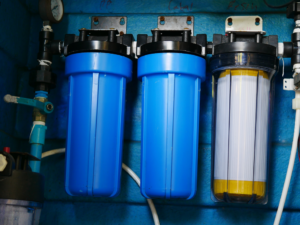
Wondering how reverse osmosis systems came to be? Then read on. We’re going to discuss their history below.
The Conception of Reverse Osmosis
The roots of reverse osmosis reach far back to 1748, a year in which French physicist Jean-Antoine Nollet used a pig’s bladder to perform reverse osmosis in a lab. While Nollet’s experimentation was useful, it had very little functional bearing on the world at the time.
However, what it did was show the potential of reverse osmosis. It demonstrated to scientists all over the world that reverse osmosis was a sound concept, and that it had the potential to make an impact in our everyday lives. In this sense, Nollet’s accomplishment can’t be overstated. It was a sign of things to come.
1949 – 1975
Remarkably, it would be over 200 years before anyone would build on Nollet’s experiment. This would occur in 1949, when researchers at the University of California, Los Angeles used reverse osmosis in the desalination of ocean water. Using a semipermeable membrane, they proved that desalination was possible.
Their experimentation would be built on 10 years later, when another group of UCLA researchers created a reverse osmosis membrane out of cellulose acetate. This membrane was more nuanced than the semipermeable membrane of a decade earlier, capable of filtering the large majority of contaminants that existed in a water supply.
However, the perfect reverse osmosis membrane had not yet been created. That wouldn’t occur until the 1960s, when John Cadotte used polymerization to make a filter that was a financially viable option for businesses and governments.
Cadotte’s technological breakthrough would start paying dividends in the early 70s, as reverse osmosis would find a welcome home in a number of industries. These industries would include the industrial and medical industries, to name just two.
1976 – 2000
One of the biggest breakthroughs for reverse osmosis came in 1977, a year in which the coastal Florida town of Cape Coral began using reverse osmosis in the desalination of its water supply. This kicked off a trend that soon spread to other coastal towns throughout the United States, causing reverse osmosis to become more and more prominent throughout the last quarter of the 20th century.
2001 – Present
These days, reverse osmosis is commonplace. Reverse osmosis systems are used in homes throughout the United States, providing homeowners with steady streams of pure and uncontaminated drinking water. Made to accommodate water supplies both small and large, they’re affordable, reliable, and beneficial.
Note, however, that the vast majority of reverse osmosis still occurs on a grand scale. In particular, municipalities use the systems during the desalination process, allowing them to produce ample amounts of clean water for their residents.
While the reverse osmosis concept is in full-swing, there’s still room for progress. As the technology associated with reverse osmosis improves, its efficiency and the cost of the process should increase and decrease, respectively. This can mean only good things.
Invest in a Reverse Osmosis System from a Hinsdale Water Softening Company
Has reverse osmosis caught your attention? Looking to invest in a reverse osmosis and water softening system in Hinsdale, Illinois? If so, the water purification specialists with DuPage Water Conditioning are the people to see.
Our team has installed reverse osmosis systems in countless homes throughout Hinsdale and its surrounding areas. We would be happy to work with you as well.
Contact us now to schedule an appointment!
